The global Anti-Wrinkle Creams Market is anticipated to be valued at USD 18,203.8 Million in 2025 and is forecast to reach USD 37,905.2 Million by 2035, reflecting an absolute gain of USD 19,701.4 Million during the period. This expansion equates to a near doubling of market value and a CAGR of 7.6% across the forecast horizon. Growth is expected to be supported by rising adoption of evidence-based skincare routines, a greater preference for clinically validated formulations, and increased awareness of proactive anti-aging practices across mature demographics.
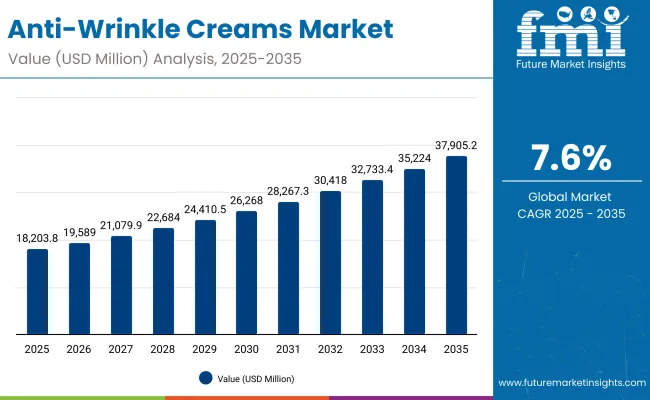
Anti-Wrinkle Creams Market Key Takeaways
| Metric | Value |
|---|---|
| Anti-Wrinkle Creams Market Estimated Value in (2025E) | USD 18,203.8 Million |
| Anti-Wrinkle Creams Market Forecast Value in (2035F) | USD 37,905.2 Million |
| Forecast CAGR (2025 to 2035) | 7.6% |
During the initial five-year span from 2025 to 2030, the market is projected to expand from USD 18,203.8 Million to USD 26,268.2 Million, contributing USD 8,064.4 Million to total growth. This phase is expected to reflect steady adoption as women aged 35+ continue to dominate usage patterns, holding 64.6% of spending in 2025, equivalent to USD 11,765.7 Million.
Clinically proven formulations are projected to account for nearly half the market, at 49.5% share in 2025, reflecting strong trust in substantiated claims. E-commerce penetration at 47.5% is also expected to anchor gains as consumers migrate toward digital channels for both convenience and access to dermatology-led assortments.
In the latter half of the decade, between 2030 and 2035, market growth is expected to accelerate by USD 11,637 Million, lifting total size from USD 26,268.2 Million to USD 37,905.2 Million. This phase is anticipated to be led by double-digit expansion in Asia, where China and India are projected to outpace mature Western markets. With clinical claim substantiation, digital-first distribution, and premiumization strategies at the forefront, the category is expected to consolidate into a high-value, evidence-driven segment by 2035.
From 2020 to 2024, the category was steadily expanded, largely influenced by premium skincare adoption and early entry of plant-based alternatives. By 2025, demand is projected to consolidate at USD 18,203.8 Million, with clinical claims and digital-first distribution establishing themselves as primary growth levers. Over the next decade, revenue is forecast to more than double, reaching USD 37,905.2 Million by 2035.
This trajectory is expected to be driven by accelerated adoption in Asia, especially China and India, where double-digit CAGRs are anticipated. Competitive dynamics are projected to remain fragmented, with the leading player accounting for only 8.1% share in 2025, reflecting intense rivalry.
Traditional leaders are expected to pivot toward clinically substantiated claims, dermatologist partnerships, and digital ecosystems, while emerging entrants are likely to compete through transparency, e-commerce penetration, and personalization strategies. By 2035, ecosystem strength, trust in clinical evidence, and ability to deliver premiumized digital journeys are expected to define the market winners.
Growth in the Anti-Wrinkle Creams Market is being propelled by rising consumer awareness of preventative skincare and a strong preference for clinically validated solutions. Adoption has been supported by evidence-backed claims, dermatologist endorsements, and transparent ingredient communication, which are expected to continue building trust.
Digital commerce expansion has accelerated accessibility, while subscription models and virtual consultations have improved regimen adherence. Premiumization has been reinforced by advances in formulations such as retinoids, peptides, and plant-based alternatives that address both efficacy and sensitivity concerns.
Regional momentum is expected to remain strongest in Asia, where double-digit CAGRs in China and India highlight untapped demand potential. Increasing lifestyle stressors, higher pollution exposure, and aging demographics are anticipated to keep demand resilient. With innovation in formulation science and alignment with sensitive-skin safety, the market is projected to expand rapidly through 2035, consolidating into a high-value, evidence-driven skincare category.
The Anti-Wrinkle Creams Market has been segmented by end user, claim, and distribution channel to capture the most influential demand patterns. The segmentation highlights how age-driven adoption, science-backed product validation, and purchasing convenience are shaping market expansion. Women above 35 years continue to represent the core consumer base, while clinically proven claims have gained prominence due to rising trust in dermatological substantiation.
E-commerce has emerged as a critical channel, reflecting digital-first purchasing behaviors and strong consumer preference for convenient access. These three segments together define the future trajectory of the market, with their relative shares expected to influence competitive strategy, product innovation, and channel investment over the coming decade.
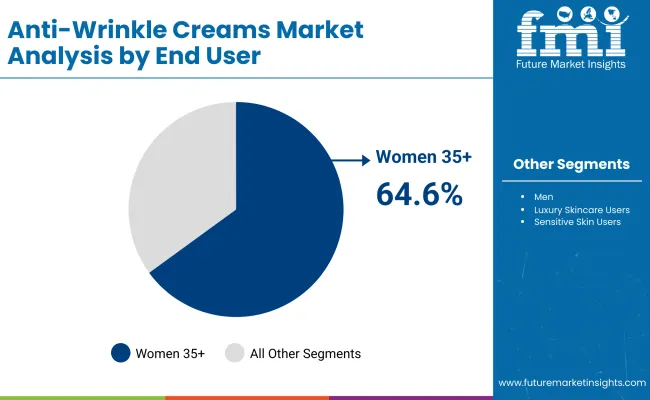
| End User | Market Value Share, 2025 |
|---|---|
| Women 35+ | 64.6% |
| Others | 35.4% |
The women 35+ segment is expected to dominate with a 64.6% share in 2025, valued at USD 11,765.7 Million. Growth in this group is being driven by heightened awareness of age-related skin concerns and greater adoption of preventative anti-aging routines. The segment’s expansion is supported by trust in clinically validated formulations and dermatologist-endorsed regimens.
Other consumer groups, including younger prevention seekers and men, are gradually increasing adoption but remain secondary in overall contribution. As brands enhance sensitivity-friendly solutions and tailor messaging for mature consumers, this segment is projected to retain its leadership throughout the forecast horizon.
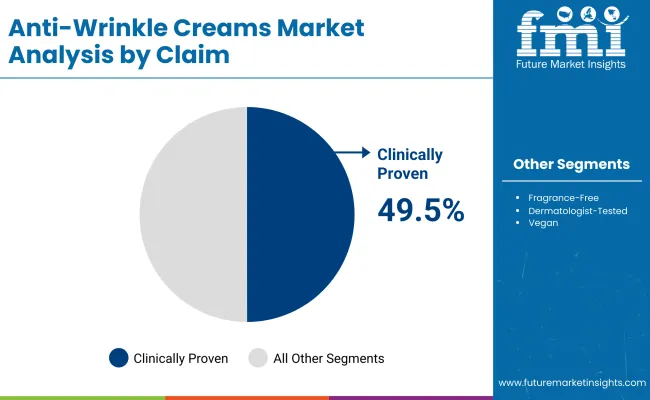
| Claim | Market Value Share, 2025 |
|---|---|
| Clinically proven | 49.5% |
| Others | 50.5% |
Clinically proven formulations are projected to capture 49.5% share in 2025, equivalent to USD 9,008.1 Million, underscoring rising consumer reliance on evidence-based skincare. The segment’s growth is fueled by increasing demand for transparency, clinical trials, and safety certifications that validate product efficacy.
With dermatologists and regulatory authorities emphasizing proven outcomes, clinically backed offerings are expected to strengthen consumer trust and justify premium pricing. Other claims, including natural, vegan, and fragrance-free, hold marginally higher share but lack the same scale of clinical validation. Future growth is anticipated to concentrate around clinically proven claims, as data-driven communication becomes the cornerstone of competitive positioning.
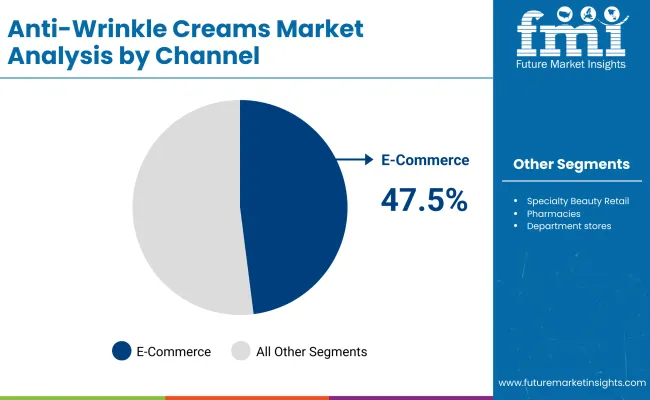
| Channel | Market Value Share, 2025 |
|---|---|
| E-commerce | 47.5% |
| Others | 52.5% |
E-commerce is forecasted to represent 47.5% of the Anti-Wrinkle Creams Market in 2025, generating USD 8,640.4 Million in value. Growth in this channel is being accelerated by consumer preference for digital convenience, online reviews, and targeted marketing campaigns. Subscription models, virtual consultations, and personalized product recommendations are strengthening the digital path to purchase. While offline channels retain a slight majority, the momentum toward online platforms is expected to intensify over the decade. With greater integration of diagnostics, tele-dermatology, and influencer-driven education, e-commerce is projected to capture an even larger role in shaping consumer engagement and brand loyalty by 2035.
The Anti-Wrinkle Creams Market is shaped by scientific advancements, digital disruption, and demographic shifts, even as premium affordability and claim validation remain critical hurdles. Opportunities and risks are expected to converge around innovation credibility, regulatory standards, and digital-first consumer journeys.
Validation through Clinical Substantiation
Market growth is increasingly being reinforced by the integration of clinical trials, peer-reviewed publications, and dermatological partnerships that substantiate product efficacy. Consumers are anticipated to align purchasing decisions with brands demonstrating transparent testing protocols and verifiable outcomes.
This shift toward data-backed claims is expected to foster long-term loyalty and defend premium positioning. With regulators and consumer advocacy groups heightening scrutiny, companies that anchor innovation pipelines to evidence-based science are projected to consolidate credibility faster. Over the forecast period, clinically proven formulations are likely to capture incremental share, positioning the market as a science-driven category rather than one reliant solely on aspirational messaging.
Acceleration of Digital Dermocosmetics
A new dynamic is emerging as artificial intelligence and virtual dermatology consultations redefine the consumer journey. By 2035, anti-wrinkle creams are expected to be increasingly integrated with diagnostic apps, personalized regimens, and subscription-based services.
E-commerce ecosystems are anticipated to evolve into digital dermocosmetic platforms that analyze skin data and recommend tailored formulations in real time. This convergence of technology with skincare is projected to create recurring revenue opportunities while simultaneously lowering consumer hesitation through data-driven personalization. Companies leveraging AI-driven insights to deliver measurable progress tracking and adaptive product recommendations are likely to gain an edge, shifting competitive differentiation away from distribution reach alone toward digital trust ecosystems.
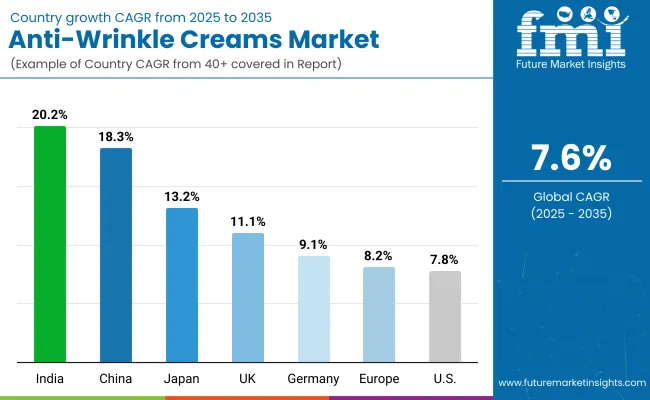
| Country | CAGR |
|---|---|
| China | 18.3% |
| USA | 7.8% |
| India | 20.2% |
| UK | 11.1% |
| Germany | 9.1% |
| Japan | 13.2% |
| Europe | 8.2% |
The Anti-Wrinkle Creams Market is projected to demonstrate distinct growth trajectories across major economies, shaped by demographic dynamics, consumer sophistication, and digital adoption. India is anticipated to emerge as the fastest-growing market, with a 20.2% CAGR during 2025 to 2035, supported by rising urban incomes, evolving beauty routines, and accelerated online distribution. China is expected to follow closely with an 18.3% CAGR, fueled by premiumization trends, stronger regulatory oversight on product efficacy, and higher demand for clinically validated formulations. Japan’s market is forecast to grow at 13.2% CAGR, reflecting a balance between tradition-driven skincare rituals and rising acceptance of advanced anti-aging formulations.
The UK (11.1% CAGR) and Germany (9.1% CAGR) are projected to anchor Europe’s demand, with a regional average of 8.2%. Regulatory scrutiny, preference for dermatologist-tested products, and aging populations are expected to drive gradual but stable expansion across these markets. In contrast, the USA is expected to reflect maturity with a relatively moderate CAGR of 7.8%, as clinical claim credibility and premium pricing remain pivotal to sustaining growth. Collectively, Asia is projected to outperform Western markets by a wide margin, with its scale, speed of adoption, and digital-first ecosystems positioning the region as the critical growth engine for the anti-wrinkle category through 2035.
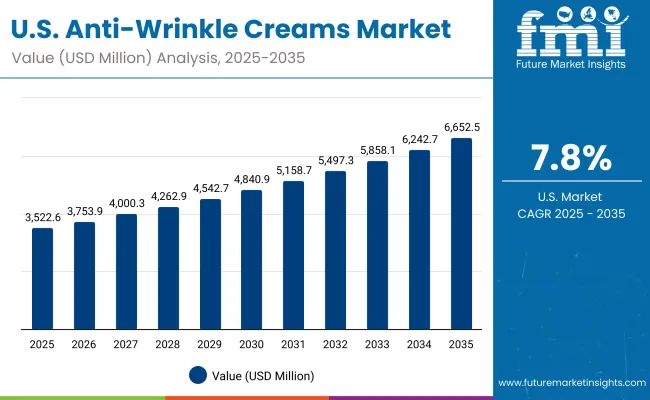
| Year | USA Anti-Wrinkle Creams Market (USD Million) |
|---|---|
| 2025 | 3,522.67 |
| 2026 | 3,753.91 |
| 2027 | 4,000.32 |
| 2028 | 4,262.91 |
| 2029 | 4,542.74 |
| 2030 | 4,840.94 |
| 2031 | 5,158.71 |
| 2032 | 5,497.33 |
| 2033 | 5,858.19 |
| 2034 | 6,242.74 |
| 2035 | 6,652.52 |
The Anti-Wrinkle Creams Market in the United States is projected to grow at a CAGR of 7.1% from 2025 to 2035, increasing from USD 3,522.67 Million to USD 6,652.52 Million. Expansion is expected to be supported by stronger adoption of premium anti-aging formulations, heightened demand for clinically validated claims, and digital-first distribution strategies. Growing interest in dermatologist-backed regimens is anticipated to sustain product credibility, while subscription models and personalized digital consultations are projected to lift adherence rates.
The Anti-Wrinkle Creams Market in the UK is projected to grow at a CAGR of 11.1% between 2025 and 2035, supported by a balanced mix of premium skincare adoption and sensitivity-focused innovations. Valuation is expected to rise steadily as consumers prioritize dermatology-endorsed and fragrance-free solutions. Digital engagement through online consultations and prescription-linked platforms is anticipated to deepen trust and conversion. A stable premium base is expected to support market resilience, even under economic pressures.
The Anti-Wrinkle Creams Market in India is forecasted to expand at the highest CAGR globally, reaching 20.2% from 2025 to 2035. Growth is expected to be accelerated by rising disposable incomes, increasing urbanization, and strong digital adoption in skincare purchases. Affordability combined with aspirational consumption is projected to create a dual market for both mass and premium brands. Social media and influencer-led education are anticipated to play a pivotal role in accelerating penetration among young prevention-focused cohorts.
The Anti-Wrinkle Creams Market in China is projected to record a CAGR of 18.3% from 2025 to 2035, positioning the country as one of the largest growth engines for the category. Expansion is anticipated to be driven by premium skincare adoption, clinical-proof demand, and digital-first purchasing behaviors. Regulatory tightening on product efficacy is expected to favor brands with transparent scientific substantiation. With livestream shopping and social commerce gaining scale, consumer education and regimen adoption are forecasted to accelerate further.
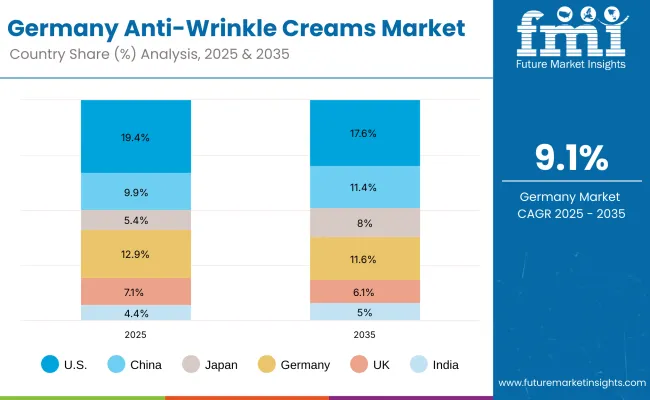
| Country | 2025 |
|---|---|
| USA | 19.4% |
| China | 9.9% |
| Japan | 5.4% |
| Germany | 12.9% |
| UK | 7.1% |
| India | 4.4% |
| Country | 2035 |
|---|---|
| USA | 17.6% |
| China | 11.4% |
| Japan | 8.0% |
| Germany | 11.6% |
| UK | 6.1% |
| India | 5.0% |
The Anti-Wrinkle Creams Market in Germany is forecasted to expand at a CAGR of 9.1% from 2025 to 2035, reflecting steady demand driven by aging demographics and strict quality compliance. Consumers are expected to prioritize dermatologist-tested, fragrance-free, and sensitive-skin formulations. Strong preference for clinical validation is anticipated to sustain premium segment dominance. Digital penetration is expected to grow gradually, as brick-and-mortar pharmacies and retail chains maintain their influence in distribution.
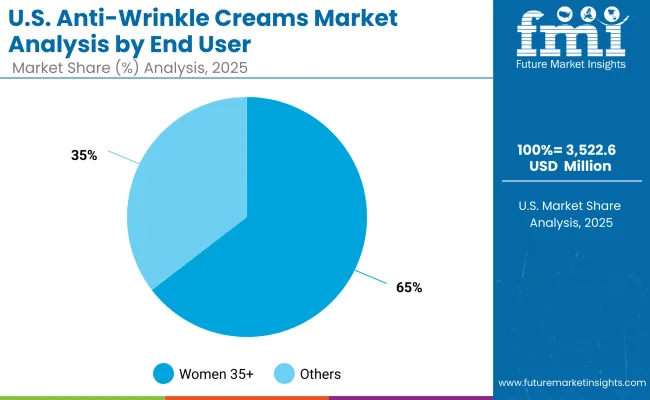
| USA by End User | Market Value Share, 2025 |
|---|---|
| Women 35+ | 64.6% |
| Others | 35.4% |
The Anti-Wrinkle Creams Market in the United States is projected at USD 3,522.67 Million in 2025. Women aged 35+ contribute 64.6%, while other users account for 35.4%, which indicates a clear concentration of value among mature skincare consumers. This dominance is explained by the heightened need for efficacy-driven formulations that address visible signs of aging, supported by dermatologist endorsements and scientifically proven claims. Other consumer groups, including younger prevention adopters and men, are gradually increasing their share, but a slower pace of adoption is anticipated relative to the core female demographic. Subscription models and e-commerce engagement are expected to reinforce long-term retention among women aged 35+, consolidating their influence on product innovation pipelines.
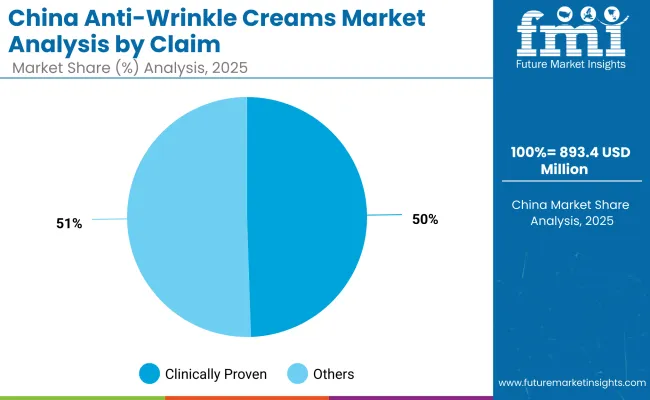
| China by Claim | Market Value Share, 2025 |
|---|---|
| Clinically proven | 49.5% |
| Others | 50.5% |
The Anti-Wrinkle Creams Market in China is projected to expand rapidly with a CAGR of 18.3% during 2025 to 2035, positioning it as one of the most dynamic global growth engines. In 2025, clinically proven formulations account for 49.5% of market value (USD 893.4 Million), while other claims represent 50.5% (USD 911.66 Million).
This near-equal split illustrates a competitive landscape where clinical validation is gaining momentum against traditional and natural positioning. Stronger regulatory oversight on product efficacy is expected to accelerate the transition toward clinically substantiated formulations. Digital-first channels, particularly social commerce and livestreaming, are projected to amplify consumer education and regimen adoption.
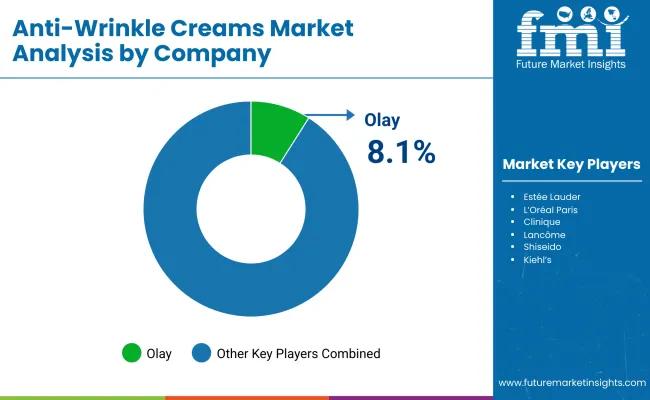
| Company | Global Value Share 2025 |
|---|---|
| Olay | 8.1% |
| Others | 91.9% |
The Anti-Wrinkle Creams Market is moderately fragmented, with global leaders, premium-focused innovators, and niche regional specialists competing across diverse consumer segments. Established leaders such as Olay (Procter & Gamble), L’Oréal Paris, Estée Lauder, Shiseido, and Lancôme hold significant visibility due to brand heritage, broad distribution, and strong dermatology affiliations. Olay dominated the global market in 2024, holding the largest individual share, which is reported at 8.1% in 2025, while the remaining 91.9% is distributed among other players.
Mid-sized innovators such as Clinique, Neutrogena, SK-II, Elizabeth Arden, and Kiehl’s have reinforced their positions by focusing on clinically validated claims, dermatologist-tested formulations, and expanding e-commerce presence. Their strategies emphasize customization, sensitive-skin compatibility, and science-led marketing, which appeal strongly to evidence-driven consumers.
Regional specialists and emerging entrants are competing through plant-based alternatives, vegan formulations, and cost-efficient products that resonate with younger prevention-focused demographics. These companies are leveraging agility and localized consumer insights rather than scale, strengthening competitiveness in Asia-Pacific and Europe.
Competitive differentiation is shifting away from product breadth alone toward integrated value ecosystems combining digital consultations, subscription-driven loyalty programs, and clinical substantiation. Over the forecast horizon, leaders that invest in scientific credibility, personalized digital pathways, and premium experience delivery are expected to consolidate share in this evolving market.
Key Developments in Anti-Wrinkle Creams Market
| Item | Value |
|---|---|
| Quantitative Units | USD 18,203.8 Million (2025); USD 37,905.2 Million (2035); CAGR 7.6% (2025 to 2035) |
| Component / Formulation Focus | Retinol & retinoid blends; Peptides; Antioxidants (vitamin C/E, coenzyme Q10); Hyaluronic acid; Plant-based retinol alternatives (bakuchiol) |
| Product Type | Day creams; Night creams; Eye/neck creams; All-in-one moisturizers |
| Claim | Clinically proven; Fragrance-free; Dermatologist-tested; Vegan |
| Distribution Channel | E-commerce; Specialty beauty retail; Pharmacies; Department stores |
| End User | Women 35+; Men; Luxury skincare users; Sensitive skin users |
| Regions Covered | North America; Europe; Asia-Pacific; Latin America; Middle East & Africa |
| Countries Covered | United States; Canada; Germany; France; United Kingdom; China; Japan; India; Brazil; South Africa |
| Key Companies Profiled | Olay; Estée Lauder; L’Oréal Paris; Clinique; Lancôme; Shiseido; Neutrogena; SK-II; Elizabeth Arden; Kiehl’s |
| Additional Attributes | Dollar sales by end user, claim, and channel; share of clinically proven claims; e-commerce/subscription adoption; dermatologist partnerships and trial-backed efficacy; premiumization and sensitive-skin innovation; plant-based alternatives (bakuchiol); social-commerce scale in China; regional CAGRs (India 20.2%, China 18.3%, Japan 13.2%, UK 11.1%, Germany 9.1%, Europe 8.2%, USA 7.8%). |
The global Anti-Wrinkle Creams Market is estimated to be valued at USD 18,203.8 Million in 2025.
The market size for the Anti-Wrinkle Creams Market is projected to reach USD 37,905.2 Million by 2035.
The Anti-Wrinkle Creams Market is expected to grow at a CAGR of 7.6% between 2025 and 2035.
The key product types in the Anti-Wrinkle Creams Market are day creams, night creams, eye/neck creams, and all-in-one moisturizers.
In terms of end users, the women 35+ segment is projected to command 64.6% share in the Anti-Wrinkle Creams Market in 2025.






Full Research Suite comprises of:
Market outlook & trends analysis
Interviews & case studies
Strategic recommendations
Vendor profiles & capabilities analysis
5-year forecasts
8 regions and 60+ country-level data splits
Market segment data splits
12 months of continuous data updates
DELIVERED AS:
PDF EXCEL ONLINE
Firming Creams and Serums Market Analysis - Size and Share Forecast Outlook 2025 to 2035
Slugging Creams Market Size and Share Forecast Outlook 2025 to 2035
Anti-Aging Creams & Serums Market Size and Share Forecast Outlook 2025 to 2035
Body Firming Creams Market Growth & Forecast 2025-2035
Eczema Relief Creams Market Analysis - Size and Share Forecast Outlook 2025 to 2035
Muscle Relaxing Creams Market Size and Share Forecast Outlook 2025 to 2035
Plant-Based Ice Creams Market Analysis by Form, Product Type, Flavor, Source, Sales Channel, and Region through 2035
Moisturizing Body Creams Market Size and Share Forecast Outlook 2025 to 2035
Age-Defying Night Creams Market Analysis - Size and Share Forecast Outlook 2025 to 2035
Probiotic-Infused Creams Market Size and Share Forecast Outlook 2025 to 2035
Hydrating Emollient Creams Market Size and Share Forecast Outlook 2025 to 2035
Cica-Infused Healing Creams Market Analysis - Size, Share, and Forecast Outlook 2025 to 2035
Vitamin E Antioxidant Creams Market Analysis - Size, Share, and Forecast Outlook 2025 to 2035
Retinoid-Infused Night Creams Market Analysis - Size, Share, and Forecast Outlook 2025 to 2035
Depilatory Hair Removal Creams Market Analysis - Size and Share Forecast Outlook 2025 to 2035
Stretch Mark Prevention Creams Market Size and Share Forecast Outlook 2025 to 2035
Lip Plumping and Filler Creams Market Analysis - Size and Share Forecast Outlook 2025 to 2035
Lightening and Whitening Creams Market Analysis - Size and Share Forecast Outlook 2025 to 2035
Coconut Oil Moisturizing Creams Market Analysis - Size, Share, and Forecast Outlook 2025 to 2035
Peptide-Enhanced Firming Creams Market Analysis - Size and Share Forecast Outlook 2025 to 2035

Thank you!
You will receive an email from our Business Development Manager. Please be sure to check your SPAM/JUNK folder too.
Chat With
MaRIA